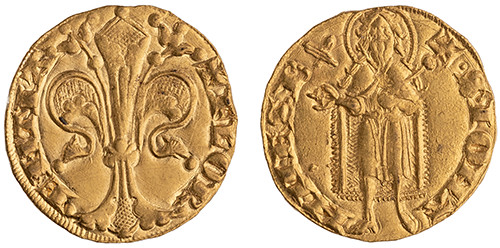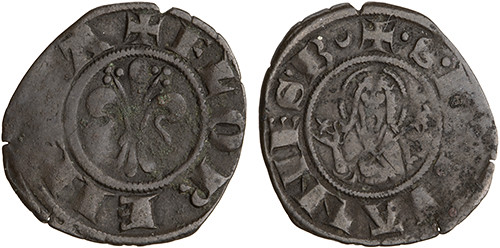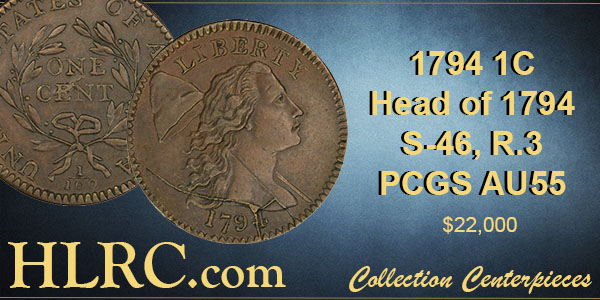
PREV ARTICLE
NEXT ARTICLE
FULL ISSUE
PREV FULL ISSUE
V25 2022 INDEX E-SYLUM ARCHIVE HOW MUCH IS THAT IN DOLLARS?An American Numismatic Society Pocket Change blog article by David Yoon explores the age-old (and difficult!) question of how much a past coin was worth in terms of present-day money. Here's an excerpt - see the complete article online. -Editor Something we are asked from time to time is how much a past coin was worth in terms of present-day money. It can be hard enough sometimes to say what the coin was worth at the time it was in circulation. Equating it to present-day money brings in some additional difficulties. Let's consider one of the most important trade coins of the late Middle Ages, the Florentine gold florin. This was famously recognized as a stable standard of value in western Europe for centuries. Many works in economic history use the Florentine florin as a standard for comparing values between late medieval currencies. There are various ways one could translate Florentine florins into United States dollars. The interesting thing is how different the results can be. First, one could start with the material of the coin itself. In medieval European monetary theory, the value of the coin was derived from its precious-metal content, in this case, gold. At a current price of 1650 dollars per troy ounce, the 3.53 grams of gold in a full-weight Florentine florin would be worth about 187 dollars. So that's one way to give a dollar value to the medieval florin. For comparing one year to another, economists use various measures to compare currency values such as the consumer price index (CPI), producer price index, and so on. These indices work by comparing prices of a variety of goods chosen to represent typical expenditures. Over time, the goods used in the index obviously change: personal computers cannot be used to measure consumer prices in 1922, whereas coal is probably not a significant part of calculation of consumer prices in the United States in 2022 (though they would certainly figure in a producer price index). However, very few goods can be compared between today and the Middle Ages, and evidence for medieval prices is limited. Ordinary consumer expenses in medieval Florence were usually reckoned in lire, soldi, and denari di piccioli, and the value of the gold florin varied relative to this money of account. This billon denaro from 1336 illustrates the base unit of this system. One commodity that does allow comparison is wheat, a basic foodstuff widely consumed both in medieval Europe and today. In Florence in the early 1330s, the price of wheat varied considerably depending on harvests (between 10 and 26 soldi per staio), but the 1331 cost of around 13 soldi per staio was not unusual. Assuming around 18 kilograms to the staio (a unit of volume), this equates to about 722 soldi per metric ton. By comparison, a metric ton of wheat currently costs about 340 dollars. A Florentine florin was worth around 60 soldi di piccioli in the early 1330s, so a metric ton of wheat would have cost around 12 gold florins at the time. In the wheat comparison, a Florentine gold florin in 1331 would be worth about 28.3 dollars. Another comparison could be made using labor costs. The federal minimum wage in the United States is currently 7.25 dollars per hour, or 58 dollars for an 8-hour day. The median cost of an unskilled manual laborer in Florence was around 4.5 soldi per day. A gold florin could thus buy 13? person-days of unskilled labor so, in terms of labor costs, a Florentine florin would be worth around 773 dollars. So three different points of comparison—wheat, gold, and unskilled labor—have given the gold florin values ranging from 28.3 to 187 to 773 dollars. All of these are reasonable points of comparison but clearly this range is so large that we have to question the meaningfulness of any one number. The relationships between agricultural productivity, household expenditure, and the overall economy are so different between 1331 and 2002 that any one point of comparison is misleading.
To read the complete article, see:
Wayne Homren, Editor The Numismatic Bibliomania Society is a non-profit organization promoting numismatic literature. See our web site at coinbooks.org. To submit items for publication in The E-Sylum, write to the Editor at this address: whomren@gmail.com To subscribe go to: https://my.binhost.com/lists/listinfo/esylum All Rights Reserved. NBS Home Page Contact the NBS webmaster 
|


